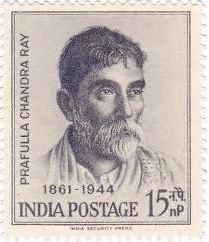MONDAY, AUGUST 04, 2025
- Home
- Acharya Prafulla Chandra Ray: The Father of Indian Chemistry
Acharya Prafulla Chandra Ray: The Father of Indian Chemistry
Commemorating the life and legacy of visionary chemist Acharya Prafulla Chandra Ray on the occasion of his 165th birth anniversary on 2nd August.
Published on Aug 1, 2025
By EMN
Share
On the occasion of Acharya Prafulla Chandra Ray’s 165th birth anniversary on 2nd August, this article commemorates the life and legacy of the visionary chemist often hailed as the Father of Indian Chemistry.

Firstly, what do we mean when we use the term ‘Indian Chemistry’? At its core, it refers not just to chemistry practiced within the geographical boundaries of India, but to a distinct tradition of chemical thought, experimentation and application that evolved over centuries through the indigenous philosophical, medicinal, metallurgical and artisanal practices. This tradition is rooted in knowledge which reveals a sophisticated understanding of substances, transformation and processes long before the rise of modern Western science. However, during the British colonial period, the deliberate dismantling of indigenous education systems and the imposition of Eurocentric scientific frameworks marginalised these rich traditions.
In this context, the work of Acharya Prafulla Chandra Ray (1861-1944) stands as a beacon. He not only pioneered modern chemical research in India but also revived and validated India’s ancient scientific heritage. Celebrating him is thus not only about honouring a great scientist – it is about reclaiming a scientific legacy and reasserting the value of Indian chemistry in both historical and contemporary contexts.
Prafulla Chandra Ray was born in a small village called Raruli-Kathipara in present-day Bangladesh and was raised in an environment that valued both learning and national consciousness. From an early age, Ray showed a keen interest in literature, languages and natural sciences and though he suffered from poor health which interrupted his formal schooling, instead of being demotivated, he used that time to read widely and cultivate a passion for science. In spite of his ill health, he passed his matriculation with distinction in 1878 and thereafter completed his B.A., majoring with Chemistry, in 1881. In 1882, he left for London for higher studies in chemistry and enrolled into Edinburgh University. There, he spent a very productive five years, earning accolades and fellowships and returned to India in 1887 after having earned his D.Sc.
After returning to India, Ray joined the Presidency College of Calcutta as a faculty in 1889 and later requested to join Calcutta University as Palit Professor of Chemistry and he remained associated with the University his entire life. An outstanding researcher, his most celebrated discovery was mercurous nitrate which he reported in 1896. Under his mentorship future scientific legends like S.N. Bose, Meghnad Saha and others were produced. His outstanding academic and research credentials won him many honours and fellowships including Companion of the Order of the Indian Empire (1912 Birthday Honours list), Knight Bachelor (1919 New Year Honours list), Faraday Gold Medal of the University of Edinburgh (1887), Fellow of the Royal Asiatic Society of Bengal (FRABS), Fellow of the Chemical Society (FCS; 1902), Honorary Member of the Deutsche Akademie, Munich (1919), etc. In 2011, the Royal Society of Chemistry honoured his life and work with the first ever Chemical Landmark Plaque outside Europe.
Another of Ray’s greatest contribution was through his role as an author and historian of science. He helped consolidate the knowledge on chemistry in Indian Knowledge Systems through his varied writings. Quoting his words, “The progress of chemical knowledge among ancient nations has always had a fascination for me. The classical works of Thomson, Hoefer and Kopp have been my favorite companions for the last twelve years or more. In the course of my studies in this field I was naturally led into an enquiry into the exact position which India occupies therein, and with this view I undertook a systematic examination, from chemical standpoint, of the Charaka, the Susruta and the various standard works of the Ayruvedic and Iatro-chemical periods, which have escaped the ravages of time” – P.C. Ray, Presidency College, Calcutta, May 1, 1892. This philosophy led to his magnus opus, a book tracing the evolution of chemistry in India from the ancient times to the sixteenth century, a testimony of his deep engagement with India’s ancient scientific traditions.
However, Ray was not just a chemist. He was a visionary and a pioneering entrepreneur. He believed that science must serve society, and at the peak of British dominance over India, he founded Bengal Chemical Works in 1892 in a rented house in Calcutta with just INR 700 which he had. In 1901, the firm became Bengal Chemical and Pharmaceutical Works Ltd., the first Indian owned pharmaceutical company. But his venture was not merely commercial, it was deeply nationalistic. Widely acknowledged as a pioneer of India’s industrial renaissance, Ray hoped to inspire Indian youth to break free from colonial economic dependency and embrace industrial entrepreneurship. He helped found the Indian Chemical Society in 1924 and the Indian Chemical Manufacturers Association in 1938. His efforts aligned scientific progress with national resurgence. He held leadership positions in organizations such as the National Education Society, Indian Science Congress Association and the Indian Chemical Society.
The Indian Council of Chemists (ICC), an apex body of Chemistry in India, has resolved to celebrate 2nd August every year as the National Chemistry Day, and it could not have been a better tribute to Acharya Prafulla Chandra Ray - a chemist, educator, industrialist, historian and patriot who set an example for all to follow on how science could serve a society and a nation.
Upasana Bora Sinha
Nagaland University

